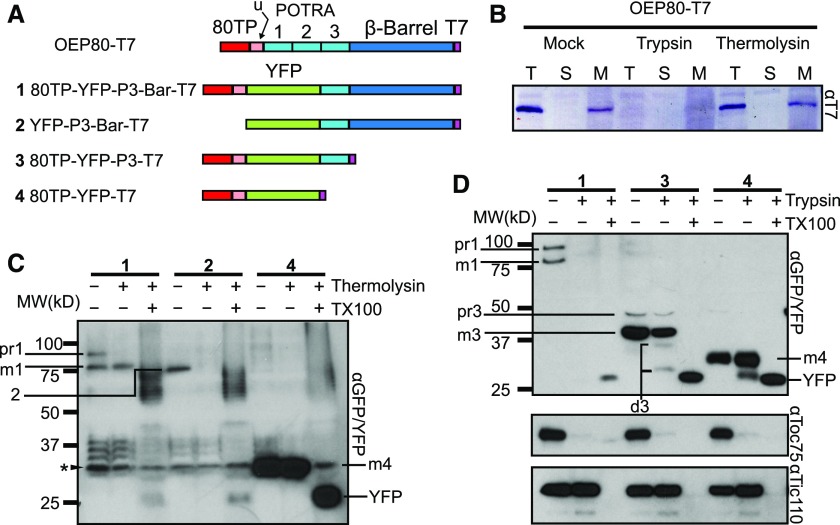Figure 4.
The N Terminus of OEP80 Is Sufficient for Targeting to the Chloroplast But the C Terminus is Required for Envelope Sorting.
(A) Diagram of constructs tested. 80TP, transit peptide of OEP80; u, uncharacterized region between the transit peptide and first POTRA. The three POTRA domains are labeled as “1,” “2,” and “3.”
(B) Chloroplasts were isolated from plants transiently expressing a T7-tagged version of OEP80. Chloroplasts were treated with no protease, trypsin, or thermolysin. Proteases were quenched, then the chloroplasts were reisolated. Chloroplasts were fractionated into soluble (S) and membrane (M). T, Total chloroplasts. Results were visualized by immunoblot with an anti-T7 antibody.
(C) Chloroplasts were isolated from plants transiently expressing YFP-tagged sections of OEP80. The chloroplasts were treated with or without thermolysin or solubilized with 1% (v/v) Triton X100 (TX100) and treated with thermolysin. After 30 min, the protease was quenched, and intact chloroplasts were reisolated. Proteins in the solubilized sample were precipitated in 80% (v/v) acetone. Samples were visualized by immunoblotting with anti-GFP antibodies. A nonspecific band recognized by the GFP antibody is indicated with an asterisks (*).
(D) The same experiment was performed as in (C), but with trypsin rather than thermolysin. Immunoblots of endogenous Toc75 and Tic110 are included as trypsin-sensitive and -insensitive controls, respectively.
In (C) and (D), the identities of bands are indicated by their number in (A) as well as “pr” to indicate the precursor form, “m” to indicate the processed form, or “d” to indicate degradation products. Free YFP that is the result of degradation of the OEP80 sections is indicated as “YFP.”

